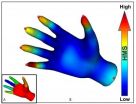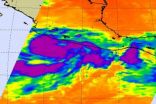(Press-News.org) WEST LAFAYETTE, Ind. - Two new techniques for computer-vision technology mimic how humans perceive three-dimensional shapes by instantly recognizing objects no matter how they are twisted or bent, an advance that could help machines see more like people.
The techniques, called heat mapping and heat distribution, apply mathematical methods to enable machines to perceive three-dimensional objects, said Karthik Ramani, Purdue University's Donald W. Feddersen Professor of Mechanical Engineering.
"Humans can easily perceive 3-D shapes, but it's not so easy for a computer," he said. "We can easily separate an object like a hand into its segments - the palm and five fingers - a difficult operation for computers."
Both of the techniques build on the basic physics and mathematical equations related to how heat diffuses over surfaces.
"Albert Einstein made contributions to diffusion, and 18th century physicist Jean Baptiste Joseph Fourier developed Fourier's law, used to derive the heat equation," Ramani said. "We are standing on the shoulders of giants in creating the algorithms for these new approaches using the heat equation."
As heat diffuses over a surface it follows and captures the precise contours of a shape. The system takes advantage of this "intelligence of heat," simulating heat flowing from one point to another and in the process characterizing the shape of an object, he said.
Findings will be detailed in two papers being presented during the IEEE Computer Vision and Pattern Recognition conference on June 21-23 in Colorado Springs. The paper was written by Ramani, Purdue doctoral students Yi Fang and Mengtian Sun, and Minhyong Kim, a professor of pure mathematics at the University College London.
A major limitation of existing methods is that they require "prior information" about a shape in order for it to be analyzed.
"For example, in order to do segmentation you have to tell the computer ahead of time how many segments the object has," Ramani said. "You have to tell it that you are expecting, say, 10 segments or 12 segments."
The new methods mimic the human ability to properly perceive objects because they don't require a preconceived idea of how many segments exist.
"We are trying to come as close as possible to human segmentation," Ramani said. "A hot area right now is unsupervised machine learning. This means a machine, such as a robot, can perceive and learn without having any previous training. We are able to estimate the segmentation instead of giving a predefined number of segments."
The work is funded partially by the National Science Foundation. A patent on the technology is pending.
The methods have many potential applications, including a 3-D search engine to find mechanical parts such as automotive components in a database; robot vision and navigation; 3-D medical imaging; military drones; multimedia gaming; creating and manipulating animated characters in film production; helping 3-D cameras to understand human gestures for interactive games; contributing to progress of areas in science and engineering related to pattern recognition; machine learning; and computer vision.
The heat-mapping method works by first breaking an object into a mesh of triangles, the simplest shape that can characterize surfaces, and then calculating the flow of heat over the meshed object. The method does not involve actually tracking heat; it simulates the flow of heat using well-established mathematical principles, Ramani said.
Heat mapping allows a computer to recognize an object, such as a hand or a nose, no matter how the fingers are bent or the nose is deformed and is able to ignore "noise" introduced by imperfect laser scanning or other erroneous data.
"No matter how you move the fingers or deform the palm, a person can still see that it's a hand," Ramani said. "But for a computer to say it's still a hand is going to be hard. You need a framework - a consistent, robust algorithm that will work no matter if you perturb the nose and put noise in it or if it's your nose or mine."
The method accurately simulates how heat flows on the object while revealing its structure and distinguishing unique points needed for segmentation by computing the "heat mean signature." Knowing the heat mean signature allows a computer to determine the center of each segment, assign a "weight" to specific segments and then define the overall shape of the object.
"Being able to assign a weight to segments is critical because certain points are more important than others in terms of understanding a shape," Ramani said. "The tip of the nose is more important than other points on the nose, for example, to properly perceive the shape of the nose or face, and the tips of the fingers are more important than many other points for perceiving a hand."
In temperature distribution, heat flow is used to determine a signature, or histogram, of the entire object.
"A histogram is a two-dimensional mapping of a three-dimensional shape," Ramani said. "So, no matter how a dog bends or twists, it gives you the same signature."
The temperature distribution technique also uses a triangle mesh to perceive 3-D shapes. Both techniques, which could be combined in the same system, require modest computer power and recognize shapes quickly, he said.
"It's very efficient and very compact because you're just using a two-dimensional histogram," Ramani said. "Heat propagation in a mesh happens very fast because the mathematics of matrix computations can be done very quickly and well."
The researchers tested their method on certain complex shapes, including hands, the human form or a centaur, a mythical half-human, half-horse creature.
INFORMATION:
Writer: Emil Venere, 765-494-4709, venere@purdue.edu
Sources: Karthik Ramani, 765-494-5725, ramani@purdue.edu
Yi Fang, fang4@purdue.edu
Related website:
Karthik Ramani: https://engineering.purdue.edu/ME/People/ptProfile?id=12331
IMAGE CAPTION:
This graphic illustrates a new computer-vision technology that builds on the basic physics and mathematical equations related to how heat diffuses over surfaces. The technique mimics how humans perceive three-dimensional shapes by instantly recognizing objects no matter how they are twisted or bent, an advance that could help machines see more like people. Here, a "heat mean signature" of a human hand model is used to perceive the six segments of the overall shape and define the fingertips. (Purdue University image/Karthik Ramani and Yi Fang)
A publication-quality image is available at http://www.purdue.edu/uns/images/2011/ramani-heat.jpg
IMAGE CAPTION:
Researchers developing a new machine-vision technique tested their method on certain complex shapes, including the human form or a centaur ╨ a mythical half-human, half-horse creature. The heat mapping allows a computer to recognize the objects no matter how the figures are bent or twisted and is able to ignore "noise" introduced by imperfect laser scanning or other erroneous data. (Purdue University image/Karthik Ramani and Yi Fang)
A publication-quality image is available at http://www.purdue.edu/uns/images/2011/ramani-heat2.jpg
Abstract on the research in this release is available at: http://www.purdue.edu/newsroom/research/2011/110620RamaniHeat.html
Genius of Einstein, Fourier key to new humanlike computer vision
2011-06-21
ELSE PRESS RELEASES FROM THIS DATE:
Bacteria develop restraint for survival in a rock-paper-scissors community
2011-06-21
It is a common perception that bigger, stronger, faster organisms have a distinct advantage for long-term survival when competing with other organisms in a given community.
But new research from the University of Washington shows that in some structured communities, organisms increase their chances of survival if they evolve some level of restraint that allows competitors to survive as well, a sort of "survival of the weakest."
The phenomenon was observed in a community of three "nontransitive" competitors, meaning their relationship to each other is circular as in ...
Picower: 1 skull + 2 brains = 4 objects in mind
2011-06-21
CAMBRIDGE, Mass. — In the 1983 movie "A Man with Two Brains," Steve Martin kept his second brain in a jar. In reality, he had two brains inside his own skull — as we all do, one on the left and one on the right hemisphere. When it comes to seeing the world around us, each of our two brains works independently and each has its own bottleneck for working memory.
Normally, it takes years or decades after a brand new discovery about the brain for any practical implications to emerge. But this study by MIT neuroscientists could be put to immediate use in designing more effective ...
Increase in survival when AED used less than 10 seconds after CPR pause
2011-06-21
TORONTO, Ont., June 20, 2011--Every second counts when performing CPR.
A new study has found the number of people who survive after suffering a cardiac arrest outside a hospital drops significantly if the pause between stopping CPR and using a defibrillator to administer an electric shock is longer than 20 seconds.
The number of people who survive rises significantly if the pause is less than 10 seconds.
"If your pre-shock pause is over 20 seconds, the chances of surviving to reach a hospital, be treated and be discharged are 53 per cent less than if the pause is ...
Energy drinks linked to substance use in musicians, study shows
2011-06-21
BUFFALO, N.Y. -- Frequent use of energy drinks is associated with binge drinking, alcohol-related social problems and misuse of prescription drugs among musicians, according to researchers at the University at Buffalo's Research Institute on Addictions.
In survey results published in the Journal of Caffeine Research this spring, UB research scientists Kathleen E. Miller and Brian M. Quigley examined substance use by 226 Western New York professional and amateur musicians aged 18-45. In the sample, 94 percent were caffeine users and 57 percent reported use of energy ...
Thunderstorms in Beatriz show strengthening toward hurricane status
2011-06-21
Tropical Storm Beatriz developed from a low pressure area that NASA was watching last week. Beatriz is now expected to reach hurricane force and hit western coastal Mexico today and tomorrow. NASA satellite imagery today revealed powerful thunderstorms bubbling within, indicating further strengthening is occurring.
Beatriz formed from the low pressure area System 92E that NASA and JAXA's Tropical Rainfall Measuring Mission (TRMM) was watching last week. The low pressure area was coming together on Friday, June 17 and had some isolated areas of heavy rainfall. Those areas ...
Fastest sea-level rise in 2 millennia linked to increasing global temperatures
2011-06-21
The rate of sea level rise along the U.S. Atlantic coast is greater now than at any time in the past 2,000 years--and has shown a consistent link between changes in global mean surface temperature and sea level.
The findings are published this week in the journal Proceedings of the National Academy of Sciences (PNAS).
The research, funded by the National Science Foundation (NSF), was conducted by Andrew Kemp, Yale University; Benjamin Horton, University of Pennsylvania; Jeffrey Donnelly, Woods Hole Oceanographic Institution; Michael Mann, Pennsylvania State University; ...
Husband's employment status threatens marriage, but wife's does not, study finds
2011-06-21
A new study of employment and divorce suggest that while social pressure discouraging women from working outside the home has weakened, pressure on husbands to be breadwinners largely remains.
The research, led by Liana Sayer of Ohio State University and forthcoming in the American Journal of Sociology, was designed to show how employment status influences both men's and women's decisions to end a marriage.
According to the study, a woman's employment status has no effect on the likelihood that her husband will opt to leave the marriage. An employed woman is more ...
Researchers find process of cervical ripening differs between term and preterm birth
2011-06-21
DALLAS – June 21, 2011 – Cervical ripening that instigates preterm labor is distinct from what happens at the onset of normal term labor, researchers at UT Southwestern Medical Center have found.
The findings challenge the conventional premise that premature cervical ripening and remodeling is likely just an accelerated version of the term labor process, and that normal term ripening is caused primarily by activation of inflammatory responses.
Cervical remodeling is the process by which the cervix is transformed to open sufficiently during the birth process.
"Premature ...
TRGroup, Inc Achieves Maryland Minority Business Enterprise (MBE) Certification
2011-06-20
TRGroup, Inc., one of Maryland's fastest growing Information Technology (IT) consulting and solutions firms, announced today that it has achieved certification as a Minority Business Enterprise with the state of Maryland. This certification makes the TRGroup, Inc. eligible to compete on the more than $80 million dollars of Maryland contracts for Information Technology services awarded through the MDOT MBE program.
"As a certified MBE in the state of Maryland, we will now have a greater ability to expand our IT services, providing support to state and local government ...
SAFE International, North America's Self Defense Leader, Launches Albuquerque, New Mexico Self Defense Seminars
2011-06-20
SAFE International is the leading provider of self defense training in North America. It currently operates throughout Canada and has expanded into Albuquerque, New Mexico with a focused marketing campaign to provide Albuquerque self defense to women, men, corporations and high schools.
SAFE International has delivered training to over one hundred thousand (100,000) people since 1994. The company is owned and managed by Chris Roberts, CEO, who is a professional teaching Director and self-defense instructor.
Ryan Fellows is the Director of Operations for SAFE International ...


